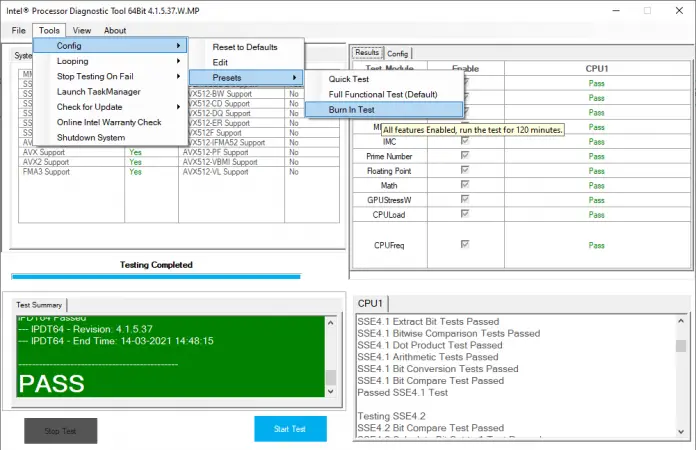

The burn-in test is an estimation method to find out the useful life of the semiconductor device. Normally, the dielectric failures, metallization failures, electromigration, and conductor failures are detected during burn-in testing of semiconductor components.
#INTEL BURN TEST CUTOFF TEMP FREE#
The devices that survive the burn-in test are the high-quality pieces that are free of latent defects and can be trusted to be incorporated in the final product assembly. The burn-in test is the best screening method to weed out initial high potential failures in semiconductor devices, otherwise called infant mortality failures. The burn-in test is conducted on each component of the production batch to ensure manufacturing standards are met and the component is reliable. The load capacity of the semiconductor device is evaluated by applying stresses such as high voltage and temperature. The test accelerates the appearance of the latent defects in the device by forcing it to undergo failure conditions under supervision. In burn-in tests, the chips, PCBs, or semiconductor devices are tested under elevated temperature, voltage, and power cycling conditions. By conducting a burn-in test, only the components having a low probability of early failure hit the market. Most of the early failures result from using defective manufacturing materials and from errors encountered in the production stage. The latent defects become prominent when the device starts operating due to the applied voltage stress and heating. Latent defects in semiconductors can be detected from burn-in tests. The burn-in test is one way to improve reduce early failure rates. To ensure this reliability, the first step is to reduce early failures. To keep up with semiconductor market standards and maintain a quality company reputation, it is mandatory to take measures to deliver only highly reliable and quality products. Looking at the curve shows us that there is no need to worry about random or wear-out failures if the semiconductor device is susceptible to early failures-its useful life is finished in the early stage of the operation itself. The curve showing the reliability of the semiconductor device over time is called the failure rate curve, or “bathtub curve”. The component increasingly undergoes wear-out failures when compared to the rate of occurrences of early and random failures. Wear-out failures are seen towards the end of the component shelf life. Random failures occur for a relatively long time and the rate of failure occurrence is also found to be constant. The rate of occurrence of early failures decreases with time. In semiconductors, the failures can be categorized as follows:Įarly failures occur in the initial stages of device operation. The burn-in test can be defined as the supervised application of electrical and thermal stress on the device to induce inherent failures. Apart from semiconductor components, PCBs, ICs, and processor parts are usually tested under burn-in conditions. As semiconductor electronics advance, burn-in testing has become a critical industry procedure to ensure quality. The Importance of Burn-In Testingīurn-in testing is a prediction method used to identify and discard defective solid-state electronic components before they reach the market or get assembled in electronic products. This test helps to ensure the reliability of the components being used in a system. The test is arranged so that the components are forced to experience certain failure conditions under supervision and the load capacity of the components is analyzed. Burn-in testing in semiconductor devices is one such technique, where components exercise failure test conditions before getting assembled into a system.

These techniques aim to protect systems from damages and failures and include traditional analytical methods, load tests, simulations, and machine learning predictions. Humans can’t predict the future, but they can predict how man-made systems will function.Įven though humans are unable to predict their own futures, we have been able to create and apply excellent techniques to predict the future of human-made systems. Types of burn-in tests include the static burn-in test, the dynamic burn-in test, and the dynamic burn-in with test. In semiconductors, failures can be categorized as early failures, random failures, or wear-out failures. The burn-in test is the supervised application of electrical and thermal stress on a semiconductor device to induce inherent failures.


 0 kommentar(er)
0 kommentar(er)
